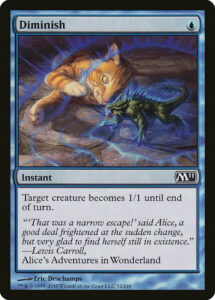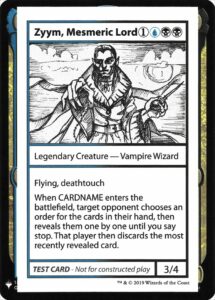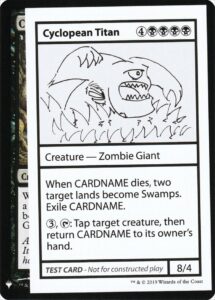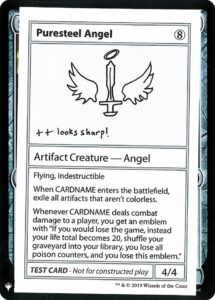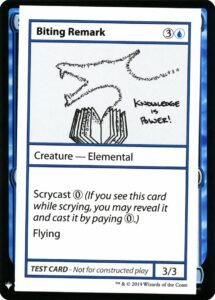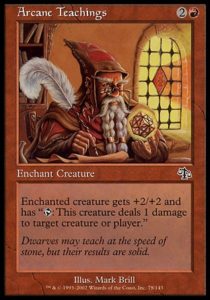Mystery Boosters are back on the menu! After a couple days of Mark Rosewater reiterating his belief that the Mystery Booster Playtest Cards shouldn’t have been made, Wizards announced we’ll be getting a chance to play with them again. These cards have been in short supply since the global pandemic cancelled the majority of 2020 MagicFests and conventions they would be opened at, so this will be a boon for anyone hoping to pick these up at a reasonable cost or just play with them.
Reading MaRo’s comments over the weekend, I still agree with him that the playtest cards are problematic. It’s dangerous for Wizards to undermine their stamp of quality by printing cards produced in a single day, with no playtesting. The cards might read well, but they could (and in some cases do) lead to awful play patterns and unfun experiences. Plus, expending so many possible ideas in one product, without considering how or when they might be used, could burn through future design space.
But when I take off my game designer hat, I can’t help but smile at memories of playtest cards. I adore the cards which run the gamut between Modern Horizons-style (wild but printable in black border) and Unstable-style (their mechanics don’t work in black border, but they follow intuition and seem super fun). Yes, there are some that instead feel Time Spiral-style (overcomplicated, underwhelming, or overly niche) or like Unhinged (dumb humor), but the player in me doesn’t want to throw the baby out with the bathwater.
So today, let’s go through a smattering of these cards. What works, what doesn’t work, and what does that say about playtest cards as a whole?
Awesome and (basically) printable
Zyym, Mesmeric Lord is just awesome. As with Atris, Oracle of Half-Truths, it creates a quick little minigame. It uses partially hidden information to let the player on the receiving end have some control over the process. It also has a backup mode, where you can use it to just Peek at your opponent’s entire hand. This in turn feeds back into the minigame, where your opponent might put their best card first to punish you (or entice you) into looking farther.
Is this the best possible expression of this effect? I can’t say, but playtesting certainly wouldn’t hurt. Maybe it would be better if it just cast Blackmail instead—a less interesting minigame that’seasier to explain and doesn’t create a recursive Yomi loop. Maybe it shouldn’t have Deathtouch, or it could just be a 2BB 3/3 Flying with Deathtouch.
There’s also the question of context, which applies to all playtest cards. Zyym isn’t meant for Standard, Commander, or Vintage, so there’s no standard to measure it up against. There’s no format to balance it for, since it’s as legal as silver-bordered cards, but silver-bordered cards are actually designed to be played against each other. This is a core tension underlying this entire array of cards and there’s no clear answer. Zyym hits about the right power level for my cube and that makes me like it more, but I also appreciate how it’s basically printable except it functions in a novel way—and that’s all good design, not power level.
The Dumb
Cyclopean Titan is making fun of Cyclopean Giant, which is itself making fun of Cyclopean Tomb and Cyclopean Mummy. Plus, it’s making fun of Cyclopean Snare, demonstrating that all Cyclopean cards are terrible.
Golgari Death Swarm is making fun of a notorious Great Designer Search 3 question that tricked a lot of people.
Seasoned Weaponsmith is making fun of Magic’s use heavy use of “Seasoned” by using it in an alternate way.
These cards are obscure self-referential jokes. They’re cute ideas that have no need to be on a card. Good for a chuckle (if you get the reference), but Cyclopean Titan and Seasoned Weaponsmith play miserably and Golgari Death Swarm has no interesting mechanical design—it’s just a Serra Angel in a color combination that can but never has gotten one.
These are among the worst kinds of designs: obviously not meant to be used. They were especially unfortunate to open in draft, since the power level of the average playtest card is so high. These make a strong case against ever doing lunch break cards again, since of course some are going to be silly jokes—in so little time, on the wrong day, with no assistance or playtesting, you are guaranteed to get some designs like that, no matter how talented your designers.
Little problems accumulating
There are plenty of playtest cards missing some polish. Control Win Condition creates an annoying bit of record-keeping that you want to obscure from your opponent (encouraging you to spend additional mental energy obscuring your busywork). Gunk Slug is a neat design that’s so frustrating to play against (I think it’s based on custom cards once played at a convention by Richard Garfield, though it might’ve been Rosewater). Whammy Burn takes a long time to understand and perform, all to say, “deal 0-4 damage to any target” via a push your luck minigame. Gold Mine is a strictly better Gemstone Mine, until it permanently turns into a Wastes, making it interesting to use for all of a three round draft.
But perhaps the most interesting problematic card is Puresteel Angel. Setting aside the utterly random bit of artifact-hosing (which I guess is a reference to Mirrodin Pure defeating the colored Phyrexians), there’s an interesting riff on cards like Platinum Angel, Lich’s Mirror, Angel of Grace, and Exquisite Archangel. But Puresteel Angel isn’t limited to a one-time use, nor does removing it stop its effect (as with Platinum Angel).
I remember a game at PAX Unplugged where someone connected with their Puresteel Angel twice. Their opponent was at a high life total and was winning the race, but the stacked-up emblems meant that all their work was in vain. Even if they could kill the Puresteel Angel, it would get shuffled back in and redrawn. They realized that the game was hopeless—they could play it out, but it would take a long time for them to eventually lose, no matter how many resources they brought to bear.
Puresteel Angel just shouldn’t be able to stack up emblems and reshuffle itself into the library. Yes, that’s the kind of design mistake that Nexus of Fate was, but hastily designed playtest cards are liable to lack crucial text tweaks that sift the fun from the miserable and generate far more such mistakes.
And everything in-between
There’s simply too much to go through in playtest cards. Biting Remark looks awesome, doesn’t really work in the rules, and generates additional excitement when you’re already doing something you like. That’s a huge win. Frogkin Kidnapper is the proto-version of Elite Spellbinder, giving playtest cards a prescient Future Sight vibe (not to mention Enchantmentize literally being a preview for One with the Stars). That’s another win.
High Troller generates ludicrously swingy board states, which is exactly what some Commander players love to do (and I had a blast losing to it in a protracted board game where it survived by ludicrous variance and eventually killed me). There are the oddball Jenny cards like Lantern of Undersight and One with Death that could be thrown into a random set, though neither probably should ever be printed. There are the minigame cards, like Xyru Specter. I adore them, even though they take too much time to explain and wouldn’t easily translate into the clean keyworded mechanics that would make them memorable.
I agree with Rosewater that there are a lot of problematic playtest cards. There are enough designs that are either pure jokes or with critical balance issues that the quality of the product as a whole greatly suffers. Magic sets simply can’t afford to have that many misses. But then again, there are so many goodies for so many people. And I don’t buy that every single card Wizards produces is meant to be played with—does that standard apply to Heroes of the Realm, or Ponies: the Galloping, or the Holiday Cards? I don’t mean to malign their designs, but I wouldn’t be surprised if fairly little playtesting went into the creation of cards that the vast majority of players won’t ever know exist, much less get their hands on.
I thought I’d come down harder on the playtest cards than I did. But I would love to see another batch of them—though ideally they’d be designed and tested over the course of a week rather than an afternoon. There’s room for improvement assuming there’s a next time, but the ceiling of the designs was so high that I do hope there is one.
And, as always, thanks for reading.
Zachary Barash is a New York City-based game designer and the commissioner of Team Draft League. He designs for Kingdom Death: Monster, has a Game Design MFA from the NYU Game Center, and does freelance game design. When the stars align, he streams Magic (but the stars align way less often than he’d like).

